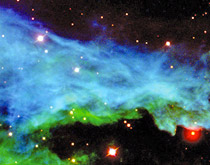A chill hangs in the dark air, and the young girl’s heart races when, all of a sudden, the sky above opens like a vast chasm and light shatters into every direction. As her eyes adjust, she marvels at the planets and constellations shooting above in bold colors.

Her parents, on the other hand, are shielding their eyes in hopes of preventing headaches. Who’s to blame them? Their daughter has insisted on sitting through the Hong Kong Space Museum Sky Show for three consecutive viewings. She wants to be showered by starlight and dance on moon beams! As the auditorium lights come up, her parents take her by the hand. “This time we really have to go! We can always come back!”
Years later, Shirley Ho still has her head in the clouds. The astrophysicist at Carnegie Mellon is leading a team of researchers who are building the Sloan Digital Sky Survey, which is a trillion-pixel map of the universe that covers more than one-third of the sky.
This is the largest map of the universe ever created. It uses baryon acoustic oscillations to analyze more than one and a half million galaxies in three-dimensional space and time. The oscillations are measured in five different colors, which determine the age and position of the galaxies. If you look at the maps, they’re bursting with color, much like the Hong Kong Space Museum Sky Show from Ho’s childhood.
—Molly McCurdy (A’10)



